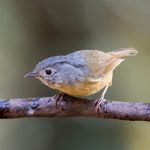 The taxonomic practice of speciation must be more art than science. After all, there are at least six distinct and recognizable populations of Dark-eyed Junco (Junco hyemalis) yet different species of scaup or Empidonax flycatcher are practically indistinguishable without resorting to DNA testing. Most higher animals are separated biologically, by the likelihood of gene flow between populations. This standard for speciation usually works pretty well, although it seems predicated on a precarious dichotomy, that of an actual vs. a potential mate. Organisms from distinct but closely related species may be able to interbreed. Some groups interbreed frequently enough that the resulting hybrids are easily recognized and sometimes even named.
The taxonomic practice of speciation must be more art than science. After all, there are at least six distinct and recognizable populations of Dark-eyed Junco (Junco hyemalis) yet different species of scaup or Empidonax flycatcher are practically indistinguishable without resorting to DNA testing. Most higher animals are separated biologically, by the likelihood of gene flow between populations. This standard for speciation usually works pretty well, although it seems predicated on a precarious dichotomy, that of an actual vs. a potential mate. Organisms from distinct but closely related species may be able to interbreed. Some groups interbreed frequently enough that the resulting hybrids are easily recognized and sometimes even named.
Assignment of species status is clearly not perfect. The continued employment of taxonomists around the world is proof that there are many organisms yet to be categorized properly. Birders, most especially listers, eagerly analyze the intermittent announcements from the American Ornithologists’ Union or similar taxonomic bodies in the hope of picking up a few previously nonexistent lifers. But as the taxonomists give by dividing a single species into two or more recognized species, a process called splitting, so do they take away by combining previously distinct species into a single one, which is called lumping. In birding, as in all other things, you roll the dice and take your chances.
So what does this have to do with teals anyway?
The Core Team, always more busy than we can stand, managed to arrange our travels yesterday so that we could drop in a particular bird. This was not birding, but rather twitching. The twitchee in this case was a Eurasian Green-winged Teal, an obliging rarity that seems committed to hanging around long enough to give every interested birder in the Tri-state a look. This duck has been holding court in Crestwood Lake in Eastchester, scant miles from our home, for at least the last two weeks. If I can blame any single factor for the fact that we were not roused to action the instant we heard of this bird, it would be that the Eurasian Green-winged Teal is not a new species for us, but a subspecies of a bird we’ve already seen.
The Green-winged Teal is North America’s smallest dabbling duck, barely bigger than a Bufflehead. The Green-winged Teal drake is marked by rich hues of pine, chestnut, peach, and pewter. The female of the species is as predictably drab as any dame duck, but wields a wing bar of such flashing electric emerald that one suspects it might be battery powered. It’s hard to say which gender is more beautiful since they are both so memorably striking.
This species is divided into two recognized subspecies. The American Green-winged Teal (Anas crecca carolinensis) can be found just about anywhere in North America, from Mexico to Alaska. The Eurasian Green-winged Teal (Anas crecca crecca) is also known as the Common Teal, but is anything but in these parts. As its name suggests, the common teal haunts the northern portions of the Old World. However, it is a casual visitor to both American coasts.
Within minutes of arriving at Crestwood Lake, we spotted a small group of green-wings, mostly drakes. Thanks to their thoughtfulness in assuming a variety of poses that accentuated their relative differences, it was no effort at all to pick out the Eurasian. Believe it or not, my meager photo above actually provides enough visual data to make the determination. In the comparison of these two subspecies, the diagnostic field mark is a white stripe. In the American teal (left), the stripe is a vertical white bar that separates the breast and flanks while the Eurasian teal (right) sports a bold horizontal stripe along its flanks. While there are a plethora of other distinguishing marks from teal head to tail (you can find a supremely comprehensive list here) the white stripe tells you everything you need to know.
So this is my call for a morphological standard for speciation, at least as far as the Green-winged Teal is concerned. Let birds that are different be different. We have two teal populations that, for the most part, do not overlap and these populations are visually distinguishable at a distance. The Green-winged Teal has already been split, in 2000, by Clements in his Birds of the World: A Checklist, considered one of the leading references on avian taxonomy. U.S. birders conjecture that the A.O.U. will eventually follow suit, a move that I wholeheartedly endorse. If the birding lobby hired a marketing consultant, the first expensive observation would undoubtedly be this: more species means more fun!











The nominate race of this duck inhabits northern Eurasia and the carolinensis race North America. For practical reasons, the European populations can be divided in two sub-populations, separated mainly by their wintering quarters. The first, estimated at 400000 individuals and undergoing a definite increase, is wintering along the Atlantic coasts from Denmark to the British Isles and Aquitaine. During very strong winters it reaches Spain and Portugal, but in mild winters the birds of the Netherlands and the British Isles are almost sedentary. The second population is estimated at 750000-1375000 individuals, but its trends are unknown. It winters in the Black Sea region and around the Mediterranean. Only a small fraction of these birds is reaching West Africa.
Check http://www.avibirds.com/html/Teal.html for more detail.